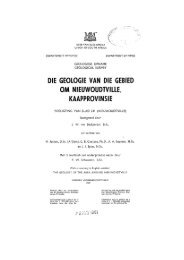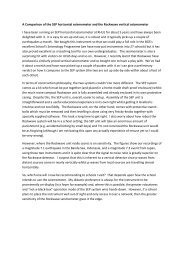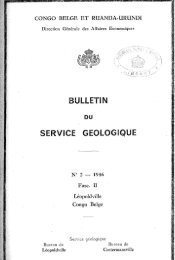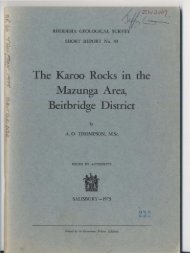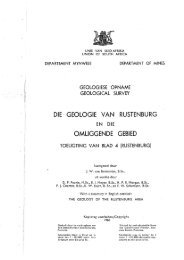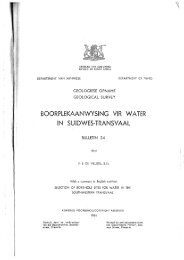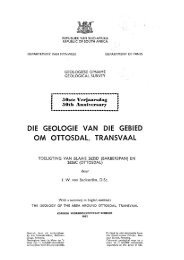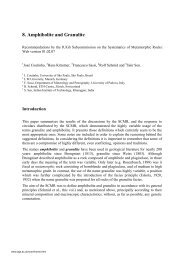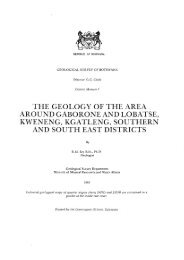Bibliography - British Geological Survey
Bibliography - British Geological Survey
Bibliography - British Geological Survey
Create successful ePaper yourself
Turn your PDF publications into a flip-book with our unique Google optimized e-Paper software.
in the ‘Purbeck Beds’, which in Woodward’s day were placed at the top of the Jurassic, but have since been<br />
reclassified as part of the Cretaceous.)<br />
Woodward, A. S. 1898. Outlines of vertebrate palæontology for students of zoology. Cambridge: University<br />
Press, xxiv, 470 pp. (Devotes three pages to the Hominidæ: ‘Of the immediate ancestors of man...scarcely<br />
anything is known from the discovery of fossil bones... The oldest known traces of a man-like skeleton seem<br />
to be an imperfect roof of a skull, two molar teeth, and a diseased femur, from a bed of volcanic ash containing<br />
the remains of Pliocene mammals, near Trinil, in central Java [Dubois 1894]... The oldest human skeletons<br />
of which the geological age is determined with certainty, are two from the cavern of Spy, near Namur, in<br />
Belgium. These were found in association with the remains of the mammoth and other Pleistocene mammals<br />
... They are essentially human in every respect, but seem to represent a race inferior in skeletal characters to<br />
any now existing. They are small, but powerfully built... This type is now generally known as the Neanderthal<br />
race; the roof of a similar skull having been found associated with other fragmentary remains so long ago as<br />
1857, in a cavern in the Neanderthal between Düsseldorf and Elberfeld, Germany. So far as can be determined<br />
from implements, man appears to have passed through three successive grades of civilization in western Europe<br />
before Britain became separated from the mainland. The earliest stones regarded as bearing traces of human<br />
handiwork, occur in certain high-level or plateau gravels in the south of England, which seem to date back to<br />
the Pliocene period before the existing valleys were excavated. These are flints merely chipped round the edge<br />
to render them more serviceable as implements. They are described as eoliths...’)<br />
Woodward, A. S. 1911. On some mammalian teeth from the Wealden of Hastings. Quarterly Journal of the<br />
<strong>Geological</strong> Society, London, 67 (2), 278–281 (with discuss). (Read 22 Mar 1911. Notes that Charles Dawson<br />
has made a determined search for further mammalian teeth in the Wealden formation of Sussex, recently<br />
assisted by P. Teilhard de Chardin and Félix Pelletier. Three further mammalian teeth have been recovered<br />
from the Ashdown Sands of the Fairlight Cliffs near Hastings. Two of these teeth, which were evidently found<br />
by Dawson, seem to belong to Plagiaulax but are very imperfect and are not illustrated. The specimens have<br />
been lodged with the Natural History Museum. The discussion which followed the reading of this paper<br />
includes remarks from Dawson, W. Boyd Dawkins and Henry Woodward. With regard to these teeth, see<br />
Clemens 1963.)<br />
Woodward, A. S. 1913. Note on the Piltdown man (Eoanthropus Dawsoni). <strong>Geological</strong> Magazine, dec. 5,<br />
10 (10), 433–434, plate XV. (Abridged from a lecture delivered to the <strong>British</strong> Association at Birmingham on<br />
16 Sept 1913, but here with the addition of a reconstruction of the skull and mandible. See Woodward 1914a)<br />
Woodward, A. S. 1914a. Missing links among extinct animals. Report of the <strong>British</strong> Association for the<br />
Advancement of Science, Birmingham, 1913, 783–787. (Lecture delivered 16 Sept 1913, including a reply<br />
to Prof Arthur Keith’s disapproval of his reconstruction of the skull and mandible of Eoanthropus dawsoni,<br />
and a report on the discovery by Father Teilhard of a canine tooth at Piltdown on 30 Aug, pp. 785–787. The<br />
lecture was briefly reported in Nature, 1913, 92 (25 Sept), 110–111, headed ‘The Piltdown skull’.)<br />
Woodward, A. S. 1914b. On an apparently Palæolithic engraving on bone from Sherborne (Dorset).<br />
Quarterly Journal of the <strong>Geological</strong> Society of London, 70 (1), 100–103 (with discuss). (Supposedly<br />
discovered by two boys of Sherborne School, but now believed to be a fake. Poor Woodward was once<br />
again duped, though he was not alone, as appears from the discussion. See Stringer et al. 1995. Ironically,<br />
this paper immediately follows the second Piltdown paper by Dawson & Woodward. See also Woodward<br />
1926.)<br />
Woodward, A. S. 1915a. A guide to the fossil remains of man in the Department of Geology and Palæontology<br />
in the <strong>British</strong> Museum (Natural History). London: Trustees of the <strong>British</strong> Museum, [6], 30 pp, 4 plates.<br />
(Piltdown man, pp. 8–23, plates I–IV).<br />
Woodward, A. S. 1915b. The Antiquity of Man, by Prof. A. Keith [review]. Nature, 96 (23 Dec), 450‒451.<br />
(Woodward is critical of Keith’s unquestioning acceptance of a Palaeolithic age for the Galley Hill (Kent)<br />
and Ipswich skeletons. In his view, Keith ‘proceeds to forfeit confidence in his conclusions by the dogmatic<br />
manner in which he accepts remains of doubtful authenticity... No geologist would do more than place such<br />
remains in a “suspense account,” and the majority would probably ignore them altogether.’ In Keith’s extended<br />
and rather discursive analysis of the skull and mandible of Piltdown man, Woodward feels that the experience<br />
of a vertebrate palaeontologist is needed to supplement and modify the ordinary methods of the human<br />
anatomist. There are some comments on Keith’s restoration of the Piltdown skull.)



